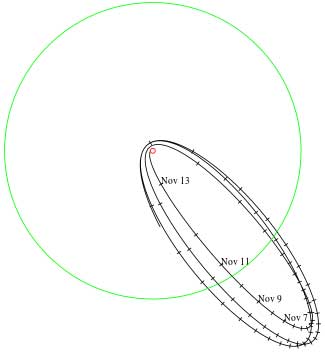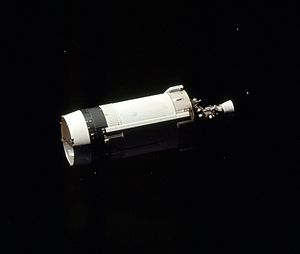WT1190F will burn up over the Indian Ocean on November 13th, giving researchers an unprecedented opportunity to follow its path — and figure out where it came from.
| Update (Nov. 13):The WT1190F UAE Airborne Campaign was successful — see video of WT1190F's reentry here. |

B. Bolin, R. Jedicke and M. Micheli
An unknown object is headed for a fiery demise over the Indian Ocean on November 13th – and observations so far show it might be a relic of the early Space Age.
The object in question is WT1190F, first observed by the Catalina Sky Survey in 2013. A couple years of observations have characterized its curious orbit: its highly eccentric path around Earth takes the object from its nearest point (perigee) of 21,221 kilometers (13,186 miles) out to an apogee of 655,370 kilometers, 1.7 times the distance between Earth and the Moon.
What Is WT1190F?

Bill Gray / Project Pluto
Studies from the International Astronomical Union’s Minor Planet Center and the European Space Agency’s NEO Coordination Centre European Space Research Institute (ESRIN) suggest that WT1190F is probably a piece of discarded space junk from a Moon mission. Not only because of its orbit, but also because WT1190 interacts with solar radiation pressure in a way that suggests it has low density and might even be hollow — perhaps a rocket booster, solar panel, or SLA Panels (Spacecraft Lunar module Adapter panels used during the Apollo missions).
Calculations project WT1190F’s reentry above the Indian Ocean, just south of Sri Lanka, on November 13th at 6:19 UT (11:49 a.m. local time).
This event provides astronomers the chance to model a reentry from a highly eccentric orbit, so they can test similar scenarios involving incoming asteroids.
“The object is quite small — at most a couple of meters in diameter — and a significant fraction, if not all of it, can be expected to completely burn up in the atmosphere,” says Tim Flohrer in a recent ESA press release.
To this end, researchers plan to conduct airborne observations of WT1190F’s atmospheric reentry from a specially equipped Gulfstream 450 business jet, an effort organized by the International Astronomical Center (IAC) and the United Arab Emirates Space Agency in cooperation with the SETI Institute, the Clay Center Observatory, and the HEFDiG (High Enthalpy Flow Diagnostics Group) at the University of Stuttgart, Germany
ESA researchers led similar airborne operations to observe the reentry of Hayabusa, an asteroid sample return mission in 2010, as well as the reentry of ATV 1, an ESA supply spacecraft for the ISS, in 2008. See the video of Hayabusa's reentry:
To date, researchers are unsure just what lunar mission WT1190F belongs to. It will probably remain a mystery unless astronomers can link it to earlier observations.
“We’ve managed to identify the object with one found in 2013,” says Bill Gray (Project Pluto), who has been working with the PanSTARRS team to identify WT1190F and characterize its orbit. “That got us a good enough orbit that Marco Micheli was able to find images taken in December 2012 from PanSTARRS in Hawaii. So about all we can say at this point is, it was launched sometime before December 2012.”
But the more observations of WT1190F, the better. WT1190F won’t pose a good observational target for backyard observers — it’s currently only at magnitude 21 near apogee, though it’ll approach magnitude 15 pre-reentry, in range of large backyard scopes. Dedicated observers can generate topocentric ephemerides using the Minor Planet Center’s Distant Artificial Satellite Observations (DASO) page.
Space Junk and Low-Flying Space Rocks

NASA
The Department of Defense's Space Surveillance Network (SSN) uses radar and optical sensors to track more than 21,000 satellites and space debris down to sizes of about 5 centimeters (2 inches) in low-Earth orbit. In farther-out geosynchronous orbits, SSN can track objects down to sizes of about 1 meter. But researchers can only recover objects in wider-ranging orbits using imaging. Small, faint objects on wider orbits are extraordinarily difficult to find, and their orbits, complicated by the gravitational effects of the Moon, are difficult to characterize.
Other near-Earth asteroid discoveries have turned out to be space junk as well: J002E3 was a Saturn V third-stage booster from the Apollo 12 mission, and 2010 QW<sub>1</sub> turned out to be part of the Chinese Chang’e 2 lunar mission. The reentry of WT1190F, however, marks the first time astronomers have observed such an object returning to Earth.
Good luck to the team watching for WT1190F’s reentry on November 13th!
Further resources:
Read Bill Gray’s FAQ page at Project Pluto for an in-depth discussion on WT1190F.
Aerospace.org provides a current list of upcoming satellite and space junk reentries worldwide.
 3
3
Comments
Tom Hoffelder
November 3, 2015 at 12:06 pm
Unknown would be better than Mystery. Mystery sounds too much like something on the History Channel about ancient aliens. The simplest answer is known, and the simplest answer is usually right, so there is no real "mystery." WT....F is cool though.
You must be logged in to post a comment.
W?ochaty-Leszcz
November 4, 2015 at 9:00 am
WT1190F impact simulation
http://www.youtube.com/watch?v=7KlqlY4cgLM
You must be logged in to post a comment.
Curt
November 11, 2015 at 1:03 pm
If this object has a perigee of 13,186 miles as stated, what explains it's sudden demise in the earth's atmosphere?
You must be logged in to post a comment.
You must be logged in to post a comment.